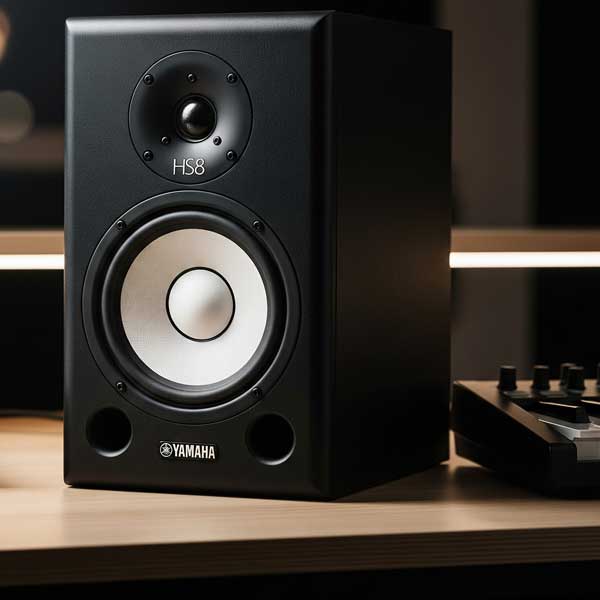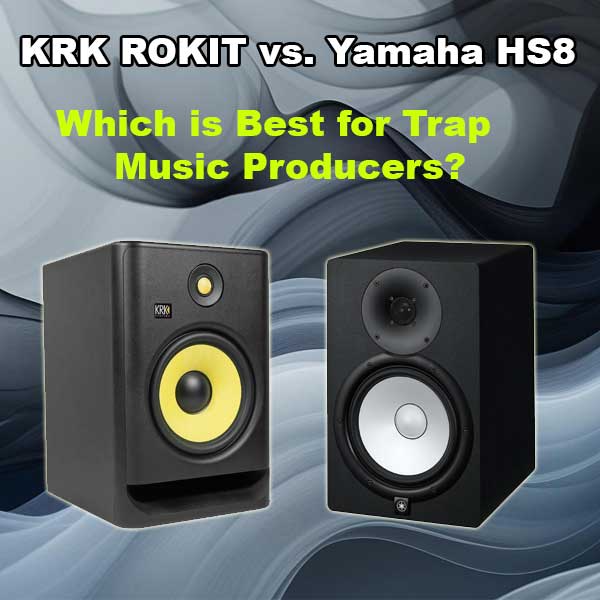HYPRVYPR.NET // GEAR REVIEWS
The 808 heavyweight championship
KRK ROKIT vs. Yamaha HS8: The Ultimate Monitor Showdown for Trap & Bass Music
Posted on: August 14, 2025
Disclosure: This article contains affiliate links. If you make a purchase through these links, HYPRVYPR.NET may earn a commission at no extra cost to you. This helps support our mission to bring you the best gear reviews.
In the world of trap and bass music, one thing reigns supreme: the low end. Your 808s need to shake the room, your sub-bass needs to be felt in your chest, and your kicks need to punch through the mix with surgical precision. But how can you craft that perfect low-end if you can't hear it accurately? That's where your studio monitors come in. They are the most critical piece of gear in your studio, and today, we're pitting two titans of the industry against each other in a battle for the title of "King of the Low End."
In one corner, we have the iconic, yellow-coned beast, a staple in countless hip-hop and EDM studios: the KRK RP8G5 ROKIT 8. In the other corner, the brutally honest, white-coned legend, revered for its unforgiving accuracy: the Yamaha HS8. Which one is right for you? Let's find out.
The Vibe Creator: KRK RP8G5 ROKIT 8 Review

You’ve seen them everywhere. From bedroom producer setups on Instagram to professional studios, the yellow and black of KRK is unmistakable. The latest 5th generation, the KRK RP8G5 ROKIT 8, continues this legacy, but with some serious upgrades that make it a compelling choice for the modern producer.
The Low-End You Can Feel
Let's get straight to it: the KRK RP8G5 ROKIT 8 is a bass machine. It's designed to be fun, inspiring, and bass-forward. The front-firing bass port minimizes boundary coupling, meaning you can place them closer to a wall without the bass getting overly muddy. For trap producers, this is a godsend. The 808s don't just sound deep; they feel punchy and present. This isn't a subtle, analytical bass; it's a confident, powerful low-end that helps you get into the groove and make creative decisions based on vibe and energy.
If you want to feel your 808s hit and get inspired while you're cooking up beats, the KRK is your creative partner. It makes the production process an absolute blast.
Versatility with Voicing Modes
The biggest upgrade in the G5 series is the onboard DSP and three distinct voicing modes. This is a game-changer:
- Mix Mode: This offers the flattest frequency response, ideal for critical mixing and mastering when you need a more neutral sound.
- Create Mode: This is where the magic happens for producers. It provides a more "inspirational" voicing, slightly boosting the lows and highs to give your sound more punch and excitement. It's perfect for beat-making sessions.
- Focus Mode: This boosts the midrange to help you focus on the clarity of vocals and other midrange instruments, similar to the classic Auratone MixCubes.
For a DJ, the Create Mode on the KRK RP8G5 ROKIT 8 is perfect for practicing sets, as it more closely mimics the hyped sound of a club system. For a producer, switching between Create and Mix mode offers the best of both worlds: inspiration during creation, and accuracy during mixdown.
The Truth Teller: Yamaha HS8 Review

If the KRK is your fun, creative partner, the Yamaha HS8 is your brutally honest mentor. Descended from the infamous Yamaha NS-10s (the monitors that, if you could make a mix sound good on them, it would sound good anywhere), the HS series is built on one principle: accuracy.
Bass That Translates
The bass on the Yamaha HS8 is tight, controlled, and unforgiving. It won't flatter your 808s or add extra warmth. Instead, it will reveal exactly what's happening in your low end. Is your sub-bass clashing with your kick? Is there too much mud around 200Hz? The HS8 will expose it without mercy. This might sound less "fun," but it's the key to a professional-sounding mix. By forcing you to work harder to get the bass right on an honest system, the Yamaha HS8 ensures your track will translate perfectly, whether it's being played on a massive club system, in a car, or on laptop speakers.
The Yamaha HS8 doesn't tell you what you want to hear; it tells you what you need to hear. It's the professional's tool for crafting mixes that stand up in any environment.
Mid-Range Clarity and Professional Tuning
Where the Yamaha HS8 truly shines is its legendary mid-range. Trap and bass music aren't just about the low end; the placement of snares, hi-hats, vocals, and synth melodies is what gives a track its character. The HS8's detailed mid-range allows you to place these elements with surgical precision. Furthermore, it features professional tuning options like the ROOM CONTROL and HIGH TRIM switches. These allow you to attenuate frequencies that might be exaggerated by your room's acoustics, giving you a flatter, more accurate response in less-than-perfect environments.
Head-to-Head: The Spec Showdown
Let's break down the technical differences between these two powerhouses.
| Feature | KRK RP8G5 ROKIT 8 | Yamaha HS8 |
|---|---|---|
| Woofer | 8" Kevlar® Aramid Fiber | 8" Cone |
| Tweeter | 1" Silk Dome | 1" Dome |
| Frequency Response | 32Hz - 40kHz | 38Hz - 30kHz |
| Total Power | 203 Watts | 120 Watts |
| Bass Port | Front-Firing | Rear-Firing |
| DSP / Tuning | Yes (3 Voicing Modes, LCD EQ) | Analog (Room Control & High Trim) |
| Sound Philosophy | Inspiring & Bass-Forward | Accurate & Flat |
The Final Verdict: Which Monitor Is For You?
After all is said and done, there is no single "winner." The best monitor for you depends entirely on your goals and workflow.
You should buy the KRK RP8G5 ROKIT 8 if:
- You are a beatmaker or producer who thrives on vibe and inspiration.
- You want to *feel* the bass and have fun during the creative process.
- You are also a DJ and want monitors that can simulate a club sound.
- You appreciate modern features like DSP voicing modes and an LCD screen for EQ.
You should buy the Yamaha HS8 if:
- Your primary goal is creating mixes that translate perfectly to other systems.
- You are a mix engineer or a producer focused on the technical aspects of sound.
- You want an honest, flat reference that will expose flaws in your mix.
- You work in a room that could benefit from analog acoustic tuning.
Ultimately, many professional studios use both: KRKs for writing and production, and Yamahas for the final mixdown. Whichever you choose, you're investing in a top-tier piece of equipment that will undoubtedly elevate your trap and bass music productions.

